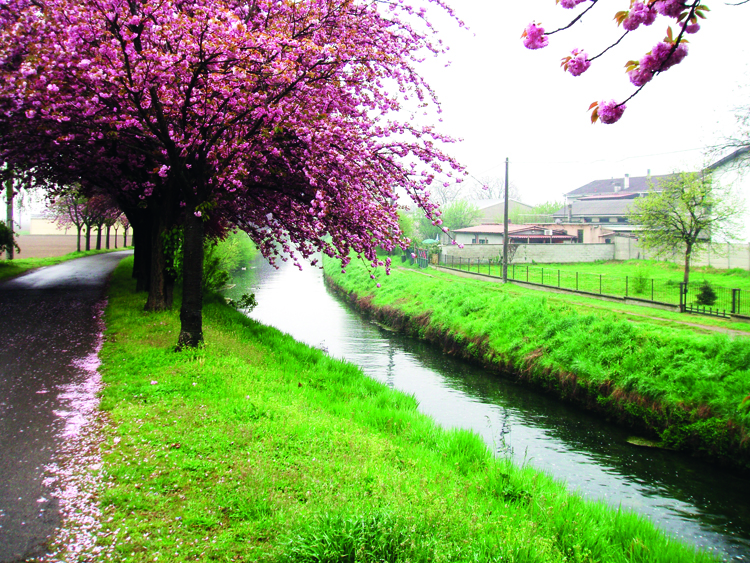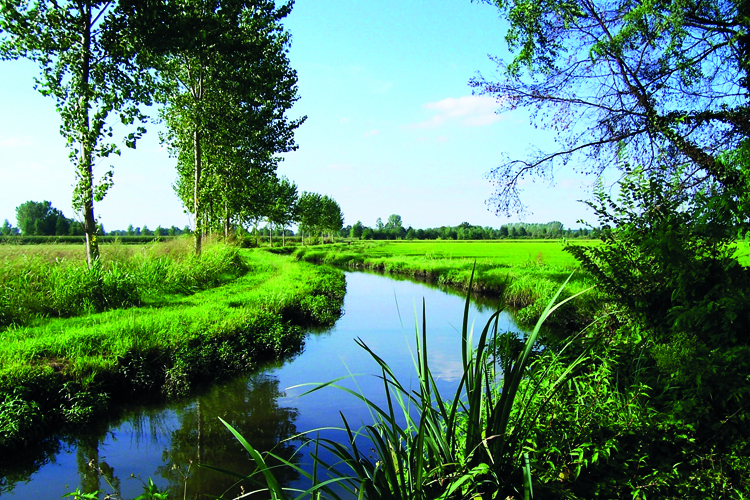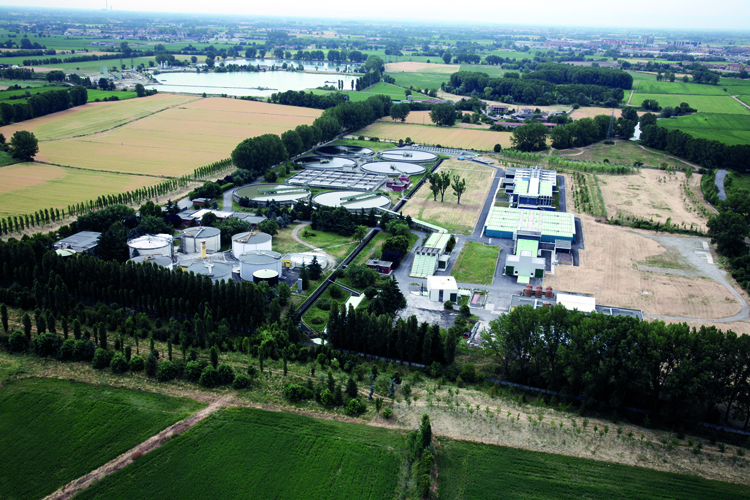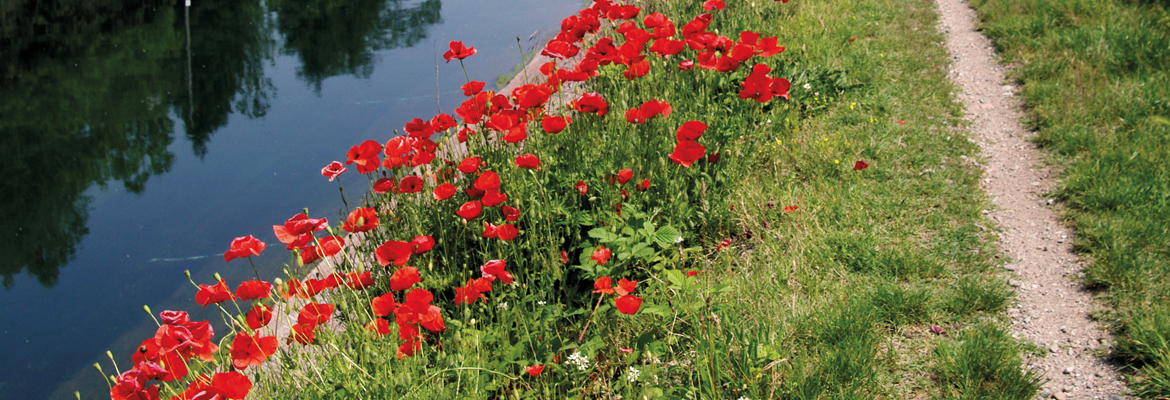Water is the best example of circularity in nature. Everybody remembers clearly the charts showing the water cycle on biology textbooks in high schools. Snow, rain, tributaries, lakes, seas, evaporation, plant nutrition, source of life for animals, basic resource for man’s social and economic development. In a continuous cycle of changes of state and ontological mutations.
A perfect cycle with a complex geography, crossing a global scale (water is a supranational resource circulating incessantly) and a regional and non-territorial scale (water basins do not stop at administrative or national borders).
Nowadays, water as an essential resource for mankind, is faced with a geographical issue.

Political geography often clashes with physical geography, without dovetailing. Does a river end at any state border? Can a municipality manage autonomously water upstream disregarding the needs of downstream municipalities? Whose responsibility are aquifers polluted in a country but consumed in another? Who pays for that? And more importantly, whose water is it?
Currently, the availability of such good is endangered and requires an effort to replenish and restore its once perfect cycle, that human activities, agriculture, overbuilding and population growth have dramatically altered, impacting on ecosystems, aquifers and water quality, limiting right of access to animals and people. The challenge of climate change and the rising trend of over three billion people along the social and food chains (more meat, more consumption) make this juncture very critical for future water supplies. If innovative solutions of circular economy for such precious resource are not found, global demand for water by 2030 could exceed supply by 40% with easily imagined consequences: wars to gain control over it, food crises and worsening of hygienic conditions.
In several European countries, where water has always been abundant, the situation looming ahead is worrying. Climate change will be the first cause affecting water availability. Indeed, according to a study carried out by the Euro-Mediterranean Centre on Climate Change (CMCC), such alteration will determine a decrease in the average snow cover and a dramatic increase in rain precipitation.
“Climate-derived impacts – explains Alessandro Russo, Gruppo CAP’s Chairman, one of Italy’s main state-owned companies – increasingly imply strong stress on treatment plants and considerable extraction from aquifers and the water supply network, with a discontinuous trend of water basin replenishment.”
Due to the agricultural sector demand, water consumption will stay high. Italy managed to bag a booby prize: according to the book Eating Planet (Edizioni Ambiente), by Barilla Center for Food and Nutrition, Italy with over 5,000 litres pro capita is ranking second in Europe for water consumption.
An attentive observer would notice that this issue is totally off the radar from the sector players such as administrative actors, public technicians, water management private and state-owned companies and those involved in land security.
“Actors are too fragmented and uncoordinated – explains Rosario Lembo, Chairman of Italian Committee for World Water Contract – they do not communicate with each other and do not collaborate. More importantly, they do not understand that water is a fundamental right.” Very few understood the value of blue gold, except for some private companies that have sensed the strategic value of its reserves for a long time. Only very few countries have a national security strategy in place for water. One of them is Israel, a historical cutting-edge country in the management of water resources.

Italy, the Imperfect Water System
In Italy, after the referendum to make water a public resource, everything went back to normal. No reforms of the water management system, no water resilience plan. Even committees just looked after their own backyard and nothing more.
As a result, water cycle management in Italy is still in chaos, with its overlapping, interference, poor integration of a system and lack of long-term plans linked to climate change adaptation. Too many players: Provinces (who will shortly pass the dossiers to Regions), Civil Protection and Civil Engineering Department (whose task is to oversee river banks and manage emergencies in case of flooding or large-scale contamination) and the Interregional Agency for the Po River (AIPO), dealing with first, second and third class hydraulic works in the Po basin.
Then there is the intricate maze of Land Reclamation Authorities, public institutions supervising the operations and maintenance of public works of reclamation checking on the activities of the private sector on their designated territory, the so called reclamation district. They deal with water security and management of waters for irrigation and the protection of the environmental and agricultural assets. It effectively overlaps Regions and partly AIPO. Then we have Drinking Water Service Boards, which are public bodies for the integrated water service, including collection, aquifer management, purification, distribution, storage and final treatment.
A huge knot to unravel to optimize management in order to make water flow in a circular manner, with no leaks, contamination, energy or environmental waste.
Suffice it to go to Germany to understand that solutions are available and cheap. “In the Ruhr area, a special legislation created water management associations, with municipalities and companies being members as well. In this way, decisions are already made on a large scale and in a strategic fashion,” explains Simone Raskob, deputy mayor of the city of Essen, boasting a 145 year-old public utility for water, the Stadtwerke Essen. “Being responsible for an entire region makes investments more efficient from an economic point of view. Moreover, a series of benchmarking projects can be carried out so that decision makers can choose the best ones.” In Essen, a holistic and integrated approach is used. For years, sewage and rainwater as well as sink wastewater have been managed separately. Thanks to an investment of €4.5 billion in the region (€490 million in the Essen municipal area alone) Emscher Conversion for the region’s water management has become one of Europe’s bigger infrastructural projects, bound to become an example for all European cities in terms of water integrated management. Actually, by 2027, according to the EU Water Framework Directive, Emscher will reach the highest ecological standard of water environmental management. High quality water with minimum costs.

Lombardy, a Changing Italy
Lombardy represents the Italian ground zero to understand the water issue and the need for a water cycle management through governance geared towards the water basin. On the one hand more water is needed for agriculture and the growing population. Simultaneously, important weather phenomena are occurring, as shown by cloudbursts and ensuing river overflows, while snowfall is less with lower water linked to snow melting. This is a worry for drinking-water management, since the so-called cloudbursts end up more and more in the sewage system, thus causing an overload in water treatment plants. And there are more risks involved.
Then, there is a peculiar issue. “In Milan, groundwater – explains Alessandro Russo – has reached unprecedented levels. Actually, there is a lake underneath the city.”
Monthly piezometrical measurements, allowing to analyse the dynamics of subterranean water flows, showed how during the years of the great industrialization – 50s and 60s – important companies such as Falk pumped out great quantities of water. In the late 80s, the aquifer began to rise again. From 6 metres, now it is only four metres below the surface. This has important consequences for the infrastructure: the underground, cellars, garages, often forced to get rid of water with draining pumps to avoid flooding.
Then there is the problem of effluent from heat exchangers. In other words, distilled water, completely devoid of impurities, coming out from air conditioners and heat exchangers. Such water also ends up in sewers “while it could safely be reintroduced into the environment, being pure water – explains Michele Falcone, CEO at Gruppo CAP – instead of affecting water treatment plants, already stressed to the limit.”

Solutions: Towards a Multi-Scale, Multidisciplinary and Circular Approach
A first integrated response to the problem of fragmentation of authority and lack of holistic vision of the water system will occur on 4th July in Milan with an international conference, organized by Gruppo CAP, where experts from Italian and European utilities will discuss the best solutions for metropolitan areas and water basins.
The aim is to understand how to manage the relation between weather phenomena, effluent from heat exchangers and mandatory use of groundwater and collection to reduce waste, water treatment overload, preserving high water quality and avoiding competition and overlapping in water management.
Gruppo Cap will initially present two proposals.
The first is a research project, carried out by the Faculty of Agriculture of Università Statale in Milan to map the secondary network of the Lombardy basin. Lombardy has a less developed hydrographic network compared to that of the 15th century. In the 12th century, the Chiaravalle and Morimondo, in the low Lombardy plain, Cistercian monks reinvented tilled land, water meadows, animal farming and wool processing and the ensuing intricate network. Then the Visconti and Sforza families came along and completed the work started by the Cistercian monks with the Naviglio Pavese and its many small canals, Naviglio Grande (used to transport marble for the Milan Cathedral), and last but not least Martesana Naviglio, made by Francesco Sforza to enrich the area and to control the flow of the Brianza watershed (rainwater coming from the hilly surroundings), with a more rational collection system of small canals fed by a controlled water flow. In this way, over 25,000 hectares of land, often flooded, and hundreds or resurgences were recovered and exploited.
An intricate and smart network that could be revamped in order to manage local waters in a sensible way. “We are working with Villoresi consortium to recover the fabric of the secondary network in the south and in the north west, including grids, small canals, Cistercian canals, ancient resurgences and locks,” explains Falcone. “We want to see and study the feasibility of spreading the water load so that it can be best absorbed by the network. This should be localised, starting from geographical and hydrological data of the Milan plain.”
In this way, restoring hundreds – perhaps thousands – of kilometres of network, great quantities of water could be saved, both from the rise in the aquifer and downpours, which could be used for irrigation – in crisis caused by climate change and prolonged droughts – thus improving water treatment quality (and ensuing consumption).
Thousands of gallons of water put back into the cycle for the benefit of the environment. “Recreating river and wet areas can contribute to restoring habit for many animals including herons and egrets as well as plants such as typha (Typha latifolia) and phragmites (Phragmites).
The other aspect being studied – which can be a source of inspiration for all Europe – is integration amongst the various levels of management. “The city’s water system must be rethought at metropolitan level by adopting a holistic vision” says Alessandro Russo. “Therefore we have to understand what the virtuous systems are. Abroad, water reclamation is the domain of institutions dealing with water services as well, i.e. they deal with drinking water then ending up in sewers and then treated. When the sewerage system interacts with the network, and therefore with water protection and hydrogeological instability, it is clear that we cannot split responsibilities amongst thousands of institutions. We asked legislators to include in our bill hydraulic works on the territory. We would be prepared to act now. But for now everything is fragmented”. So much for the circular economy.
How to start? First of all amalgamating subsidiaries with reclamation consortia. As the mayors of Barcelona, Rotterdam and Essen at the conference organized by CAP will tell us, we need to study the best foreign practices to maximize results, paying attention to contextual solutions. After all, Italy and Europe already offer good examples... For once, it is a matter of copying and adapting them to the context.
Euro-Mediterranean Centre on Climate Change, www.cmcc.it/it/
Barilla Center for Food & Nutrition, Eating Planet. Food and Sustainability: Building our Future, Edizioni Ambiente 2016; www.edizioniambiente.it/libri/1108/eating-planet/
Italian Committee for World Water Contract, contrattoacqua.it/
Info



